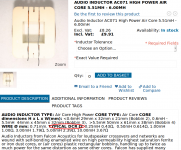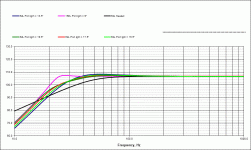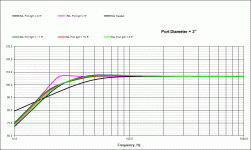Hey all,
I'm looking into building a pair of Tarkus as I'm going to be off work for a while longer (I work in live sound).
I have a question regarding the port location. Most of the speakers I've owned are front ported. I'm wondering if it might be advantageous to move the port to either the front or possibly the bottom of the speaker? (I was planning to raise them up a little anyway)
Would love some insight on this is.
Thanks,
BlindMelon7
Edit: might it even be possible to make them Aperiodic? Pretty much all of my current speakers are either transmission line or sealed so I'm a little worried about "boominess"
I'm looking into building a pair of Tarkus as I'm going to be off work for a while longer (I work in live sound).
I have a question regarding the port location. Most of the speakers I've owned are front ported. I'm wondering if it might be advantageous to move the port to either the front or possibly the bottom of the speaker? (I was planning to raise them up a little anyway)
Would love some insight on this is.
Thanks,
BlindMelon7
Edit: might it even be possible to make them Aperiodic? Pretty much all of my current speakers are either transmission line or sealed so I'm a little worried about "boominess"
Last edited:
No problem at all to front port it. Look at Paul's page for that speaker and you will see more than a couple of versions with front ports.
No problem either for a bottom port. B&W is (was?) fond of doing it that way. Rule of thumb I think is to give an amount of clearance equal to the port diameter. I'm sure someone will correct me if I'm wrong.
A whole lot of people have been very happy with Paul's design but if you are worried about boominess you could go sealed depending on your room size (small would be better) and tastes. Sealed F3 is about 48Hz in 60L which if I remember correctly is about right for the Tarkus. I'm not sure aperiodic would offer any advantages here.
Another approach would be to start with the port about 3" longer than suggested. Listen and then shorten by about an inch repeatedly until you like what you hear. I will say though that when I model what the Tarkus is doing with that Peerless woofer, the knee of the rolloff is already more gentle than normal which is what you want to do to avoid boominess when F3 is quite low.
No problem either for a bottom port. B&W is (was?) fond of doing it that way. Rule of thumb I think is to give an amount of clearance equal to the port diameter. I'm sure someone will correct me if I'm wrong.
A whole lot of people have been very happy with Paul's design but if you are worried about boominess you could go sealed depending on your room size (small would be better) and tastes. Sealed F3 is about 48Hz in 60L which if I remember correctly is about right for the Tarkus. I'm not sure aperiodic would offer any advantages here.
Another approach would be to start with the port about 3" longer than suggested. Listen and then shorten by about an inch repeatedly until you like what you hear. I will say though that when I model what the Tarkus is doing with that Peerless woofer, the knee of the rolloff is already more gentle than normal which is what you want to do to avoid boominess when F3 is quite low.
Sounds sensible. If you consider the I/O in a cylinder head, the valves don't open far, it's the diameter that makes it significant.Rule of thumb I think is to give an amount of clearance equal to the port diameter.
While I've got you, do you guys mind casting an expert eye over my crossover components? My main concerns are:
Is the 0.71mm cable suitable for the inductors.
Is it a bad idea to run two parallel pairs of 2ohm resistors to make up a 4ohm resistor? I'm not entirely sure what the downsides are to it, but I'm struggling to find 4ohm resistors.
My final question (for now) is regarding the cabinet damping. Paul Carmody suggests egg crate foam in the bass cabs and polyfill in the tops. Is there an alternative to egg crate foam for the bass? It's surprisingly expensive, and in the acoustic treatment world it's generally considered ineffective (although it might be different in this scenario).
Apologies for all the questions - this is my first build so I'm probably overthinking things.
Edit: shopping list attached
Is the 0.71mm cable suitable for the inductors.
Is it a bad idea to run two parallel pairs of 2ohm resistors to make up a 4ohm resistor? I'm not entirely sure what the downsides are to it, but I'm struggling to find 4ohm resistors.
My final question (for now) is regarding the cabinet damping. Paul Carmody suggests egg crate foam in the bass cabs and polyfill in the tops. Is there an alternative to egg crate foam for the bass? It's surprisingly expensive, and in the acoustic treatment world it's generally considered ineffective (although it might be different in this scenario).
Apologies for all the questions - this is my first build so I'm probably overthinking things.
Edit: shopping list attached
Attachments
The resistance of the larger inductor being over 2 ohms is likely to have a small but noticeable effect on the response. In addition this resistance will probably make the inductor warm when used for bass duty, possibly too warm.
That's OK, 2 in series will make 4 ohms. You should be able to find 3.9Is it a bad idea to run two parallel pairs of 2ohm resistors to make up a 4ohm resistor?
Attachments
Your shopping list is missing the Peerless midranges.
Well spotted, Falcon don't sell them so I'm getting those elsewhere. I don't think it would sound very good without those.
The resistance of the larger inductor being over 2 ohms is likely to have a small but noticeable effect on the response. In addition this resistance will probably make the inductor warm when used for bass duty, possibly too warm.
I suspected as much. It might have to be a ferrite core as the lower resistance air core version is way out of my price range. Is the extra distortion likely to be noticeable?
Non-linear distortion, within reasonable limits, is not a significant problem. The issue goes beyond that where the chosen core isn't large enough for the duty it is chosen for. The core becomes significantly saturated in use and the effective inductance drops to what it would be without the core.
In other words, it may not or it may.
In other words, it may not or it may.
I think I'll start with a longer port placed at the bottom and experiment from there as jReave suggested.
In theory I thought it would be a good idea but I just did the sims and the changes don't really affect the response all that much. I probably should have done that before making the suggestion. Oops.
Attached below are response comparisons using different length ports. First pic is with the 4" diameter port and the next is with the 3". Curves are labeled so it should be self explanatory. The suggested "ideal" tuning with 150L is also included as well as the sealed response.
As you can see, the Tarkus is already hitting a response that is right in the middle or so between the sealed and "ideal" vented alignments. That should go a very long way to avoiding boominess when you take the room gain into account. Play around with the port lengths if you feel like it but I'm not sure if you are really going to hear that much of a difference.
Note that longer port lengths may need an elbow in the port which kind of makes it easier to remove just 1 section of the port and cut it to a different length.
And an iron core is indeed recommended for the 6mH inductor. Keep its resistance as low as possible though, down around 0.3ohm would be good.
Attachments
Attached below are response comparisons using different length ports. First pic is with the 4" diameter port and the next is with the 3". Curves are labeled so it should be self explanatory. The suggested "ideal" tuning with 150L is also included as well as the sealed response.
Fantastic! Thank you so much for taking the time to run these. I'm liking the look of the response - I much prefer a smoother roll-off. I'm using PMC TB2s at the minute, they're great for more critical listening but I'm hoping the Tarkus are going to be a little more "fun" as the PMCs can come across as a tad polite.
What software are you using to calculate the response?
For now I'm going to get my boxes made until my parts arrive. I found a place that will cut the MDF for pennies which should save me some time on the table saw. It's a long shot but I don't suppose anyone has a cut list or a sketchup file they could send over? I'm painfully slow on sketchup!
That would also come from Unibox. The suggested alignment is in 150L tuned to 26Hz for an F3 of about 23Hz. Unibox calls this the "standard" design. See the graphs in post #12.
The alignment that Paul C has chosen in about 62L is an excellent example of why the standard design is not always the ideal choice. First the more gradual rolloff at frequencies down around 30Hz should result in a much better in-room response (which is not actually the case if the tuning frequency is up around 80Hz for eg - depending on room size of course) and second, it's going to result in a much more reasonably sized speaker for the average person.
Play around with the box modeling yourself - you should get the jist.
The alignment that Paul C has chosen in about 62L is an excellent example of why the standard design is not always the ideal choice. First the more gradual rolloff at frequencies down around 30Hz should result in a much better in-room response (which is not actually the case if the tuning frequency is up around 80Hz for eg - depending on room size of course) and second, it's going to result in a much more reasonably sized speaker for the average person.
Play around with the box modeling yourself - you should get the jist.
I'm having a lot of fun with unibox. I'd quite like to design something from scratch for my next build - I've always fancied doing something with ribbon tweeters, my old Leak 3090s have ribbons and I love that sound.
I've just sent off a cut layout to the MDF guys. I'm relieved I don't have to cut all that MDF myself - while I do have access to a table saw, I don't have a proper dust extractor so it would have been a nightmare. However I just realized I didn't account for bracing - I've taken the dimensions directly from the plans on Paul's website. How would one calculate the internal volume of a speaker after the fact? Short of pouring water into it and measuring the result!
I've just sent off a cut layout to the MDF guys. I'm relieved I don't have to cut all that MDF myself - while I do have access to a table saw, I don't have a proper dust extractor so it would have been a nightmare. However I just realized I didn't account for bracing - I've taken the dimensions directly from the plans on Paul's website. How would one calculate the internal volume of a speaker after the fact? Short of pouring water into it and measuring the result!
- Status
- This old topic is closed. If you want to reopen this topic, contact a moderator using the "Report Post" button.
- Home
- Loudspeakers
- Multi-Way
- Front Ported Tarkus?




